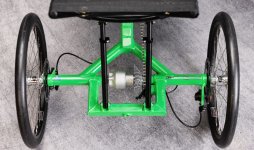You won't get any more power or capability doing it the proposed way vs separate wheels.
You just get more stress on the single wheel.
You can setup your system in the ebikes.ca simulator and see what will happen for each motor, setting it up as 2WD.
Just like separately-powered wheels, if the two motors are not identical in properties and/or controlled by a smart enough system that doesn't just feed them identically, then whichever one has a higher kV (vs gearing/wheelsize between it and road to give final RPM) will be trying to spin faster than the other and taking more of the load, assuming they are controlled by speed-modulating controllers.
If they are controlled by torque-modulating controllers, then whcihever one has a higher kT will take more of the load (again, dependiong on specific gearing/wheelsize)
If they are identical in properties and controlled identically, then they will both supply equal speed / torque in lockstep.
If the controlling method takes the kV / kT and gearing / wheelsize into account and produces throttle inputs to each controller along a curve specific to that, it could keep the speed / torque the same on both so they both share equally in driving the system.
If the controlling method takes no account of anything and simply drives them identically, then if they're just speed controllers the faster motor will really be doing "all" the work (depending....). Torque controllers will share the load in some proportion at least.
Trikes don't use rear brakes except as parking brakes, so no loss.
Yours might not, but it's not a universal thing.

In case it's something you just didn't know about (and might affect future trike-purchase or design considerations):
For delta trikes, my SB Cruiser used to (but they were crappy and ineffective junk so I took them off, someday will have disc rear). Trucktrike (or triketruck?) uses disc rears. Various pedicabs have rear brakes, as do a number of other delta trikes and trike kits to add to bike frames. Those with a single live axle often use a rotor on the axle rather than the wheels, but some use them on the wheels instead.
For tadpole trikes, I've seen various pics showing rear brakes (rim or disc) on at least some over the years, though don't know which ones they were.



